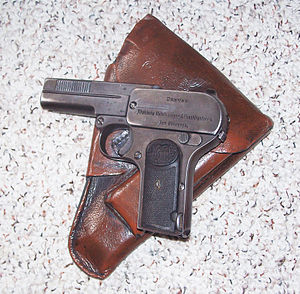Dreyse M1907
| Dreyse Model 1907 (Dryese M1907) | |
|---|---|

Dreyse m1907. This example has World War I Imperial German ordnance acceptance stamps, and a late World War II issued Presstoff holster
|
|
| Type | Semi-automatic pistol |
| Place of origin | German Empire |
| Service history | |
| In service | 1907–1945 |
| Used by | See Users |
| Wars | World War I, World War II |
| Production history | |
| Designer | Louis Schmeisser |
| Designed | 1905–1906 |
| Manufacturer | Rheinische Metallwaaren- und Maschinenfabrik AG |
| Produced | 1907-1915 |
| Specifications | |
| Weight | 710 g (1 lb 9 oz) |
| Length | 160 mm (6.3 in) |
| Barrel length | 92 mm (3.6 in) |
|
|
|
| Cartridge | 7.65 mm Browning (.32 ACP) |
| Caliber | 7.65 mm |
| Action | blowback, unlocked breech |
| Muzzle velocity | 365 m/s (1,200 ft/s) |
| Effective firing range | Sights set for 25 m (82 ft) |
| Maximum firing range | 50 m (164 ft) effective range |
| Feed system | 7-round detachable single-stack magazine |
| Sights | Rear notch and front blade post |
The Dreyse Model 1907 is a semi-automatic pistol designed by Louis Schmeisser. The gun was named after Nikolaus von Dreyse, the designer of the Dreyse Needle Gun. The Waffenfabrik von Dreyse company was acquired by Rheinische Metallwaren & Maschinenfabrik Sömmerda in 1901, although the Dreyse Model pistols were marketed under the Dreyse name.
The pistol had an interesting feature for the time: when the gun was ready to fire, the firing pin projected through the back of the breech block, serving as an early handgun-cocking indicator. For cleaning, the frame, receiver and slide pivoted forward on a pin in front of the trigger guard. The pistol and its derivatives (Dreyse Model 1907 Pocket Pistol, Dreyse Model 1912 Parabellum) was of simple blowback recoil operation, though of unusual design.
The same company also manufactured a 6.35 mm pocket version (also named Model 1907). In 1912 the 9 mm Parabellum Dreyse Model 1912 emerged as the gun's successor. Marked as the RM & M Dreyse, it was chambered for 9 mm Parabellum.
Despite the gun's limited production time, the gun is relatively common today, in large part due to its use by Volkssturm and Volksgrenadier late in World War II, enabling many Allied servicemen to bring examples home as war trophies.
The Waffenfabrik von Dreyse was founded around 1841 to manufacture the famous Dreyse Needle gun for the Prussian Army, and they also made needle-pistols and caplock revolvers. The Dreyse Factory went into decline after the German Army adopted the Mauser in 1872. In 1901 Rheinische Metallwaren- & Maschinenfabrik of Sömmerda purchased Waffenfabrik von Dreyse.
...
Wikipedia
